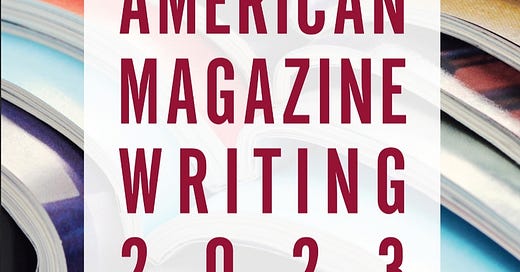I read the 2022 edition of 'The Best American Magazine Writing' last year and loved it for the extreme diversity of topics that it offered along with the excellent quality of writing. While I was reading the latest book that compiled the best American magazine articles of 2023, I felt that there was something amiss about it. The quality of the articles is pretty good, but by the time I reached halfway through it, I was getting fatigued. By then there was a pattern emerging; it felt like a fixed template governed the selection of articles instead of the merit in them. The sheer diversity of the content, which was also a pleasingly disconcerting feature of the previous edition, was no longer available.
Then I noticed that another US election was upcoming and knew I had cracked the puzzle. Who needs to read about science conquering newer frontiers, about someone finding inspiration and doing something awesome, or about interesting personal perspectives that could enrich lives during election time? It's time to scratch the itches ferociously. Thus I found an entire six-hundred-page book exposing the real and imagined fault lines of US society and its system. My issue is not the articles themselves, but compiling a book that's supposed to contain the best articles of last year with only the most depressing ones among them.
The book is edited by Sidney Holt for the American Society of Magazine Editors and published by Columbia University Press. I received a review copy through Netgalley in exchange for feedback. The book opens with an introduction from Natasha Pearlman, the executive editor of Glamour, where she goes on and on about how magazine writing is awesome and why writers are doing the work of God. Then we have an obligatory 'Acknowledgements' from the editor Holt, who claims there are twenty-two articles that show the power of magazine writing. But the table of contents shows only nineteen. To arrive at twenty-two as claimed by Holt, we need to count the 'Introduction', his 'Acknowledgement', 'Permissions', and 'List of Contributors'. I don't know how to believe the many statistical figures quoted in the articles if the editor himself finds it difficult to process numerical data.
The real article that opens the compilation is titled 'The Battle for Baby L' written by Rozina Ali for the New York Times. It's about an orphaned baby girl who was illegally abducted to the US and her Afghan relatives denied the opportunity to even see her. Out of the nineteen articles, seven deal directly with parent-children issues, including the sole fiction piece, a lame effort that never rises above mediocrity. Out of them, a piece called 'The Landlord and the Tenant' is a marvelous one that showcases the possibilities of this medium more than any other article in the book. It follows two contrasting stories of a tenant and her landlord that intertwine at a tragic fire incident. The overall picture that comes out of these articles is the sheer lack of social, economic, and physical safety for kids and parents, especially mothers in the US.
Out of the others, the last and longest piece, titled 'Untold', turns out to be the most devastating. It's the account of a gifted college football player who raped and assaulted multiple women but was never served the justice he deserved due to the possible interference of the coach and the university. 'Light and Shadow' is an excellent profile of the artist Matthew Wong, who committed suicide right when the world was taking notice of his brilliant paintings. Another profile of the actor Viola Davis started well but soon turned out to be just a promotional piece for her movie.
You find a piece that sings the virtues of excessive drug use and explains how riding a car at lightning speeds under the influence can be a healing experience, another that analyzes how Tinder revolutionized dating culture, and one more that tries to understand the culture of celebrating nepo kids. All are as shallow as they sound. There are a few good articles that dig into the forgotten past, like the one about the hardware heists by the Asian mafia that occurred in Silicon Valley before the dot-com boom.
Overall, the book is an underwhelming effort when compared with last year's collection. But still, there is enough excellent stuff in it that wouldn't disappoint a reader who is okay with the constant barrage of pessimistic observations.






Interesting. Never knew about this collection. Right time for this review too. Soon after the amazing debate. .